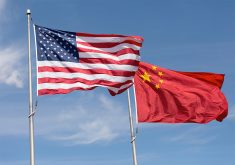[UPDATED] Reuters—President Donald Trump is not imposing his new 10 per cent global tariff rate on goods from Canada and Mexico while his previous order remains in place for up to 25 per cent tariffs on many goods from the two in connection to border control and fentanyl trafficking issues, according to a White House fact sheet released on Wednesday.
“For Canada and Mexico, the existing fentanyl/migration … orders remain in effect, and are unaffected by this order,” the White House fact sheet said.
“This means USMCA (U.S.-Mexico-Canada Agreement) compliant goods will continue to see a 0% tariff, non-USMCA compliant goods will see a 25% tariff, and non-USMCA compliant energy and potash will see a 10% tariff. In the event the existing fentanyl/migration … orders are terminated, USMCA compliant goods would continue to receive preferential treatment, while non-USMCA compliant goods would be subject to a 12% reciprocal tariff.”
Read Also

Nutrien tops profit estimates, launches review of phosphate business
Nutrien beat analysts’ expectations for third-quarter profit on Wednesday, and said it would initiate a review of strategic alternatives for its phosphate business.
Widespread 10 per cent tariffs
President Donald Trump said on Wednesday that he would impose a 10 per cent baseline tariff on all imports to the United States and higher duties on dozens of the country’s biggest trading partners.
Trading partners are expected to respond with countermeasures of their own that could lead to dramatically higher prices for everything from bicycles to wine. U.S. stock futures sank following his announcement.
“It’s our declaration of independence,” Trump said at an event in the White House Rose Garden.
Trump displayed a poster that listed reciprocal tariffs, including 34 per cent on China and 20 per cent on the European Union, as a response to duties put on U.S. goods.
A White House official, speaking on condition of anonymity, said those penalties will take effect on April 9 and will apply to about 60 countries in all.
The baseline 10 per cent tariff will take effect on Saturday, the official said.
Following his remarks, Trump signed an order to remove a “de minimis” tariff exemption on low-cost products. Trump is also planning other tariffs targeting semiconductors, pharmaceuticals, and potentially critical minerals, the official said.
Trump’s barrage of penalties has rattled financial markets and businesses that have relied on trading arrangements that have been in place since the middle of last century.
Auto tariffs to take effect
The administration has said the new tariffs will take effect immediately after Trump announces them, though it has not yet published the official notice required for enforcement.
The administration, however, did publish an official notice that a separate set of tariffs on auto imports that Trump announced last week will take effect starting on April 3.
Trump has already imposed 20 per cent duties on all imports from China and 25 per cent duties on steel and aluminum and extended them to nearly $150 billion worth of downstream products.
His advisers say the tariffs will return strategically vital manufacturing capabilities to the United States.
Outside economists have warned that tariffs could slow the global economy, raise the risk of recession, and increase living costs for the average U.S. family by thousands of dollars. Businesses have complained that Trump’s barrage of threats has made it difficult to plan their operations.
Tariff concerns have already slowed manufacturing activity across the globe, while also spurring sales of autos and other imported products as consumers rush to make purchases before prices rise.
Financial markets were volatile as investors awaited Trump’s announcement. U.S. stocks have erased nearly $5 trillion of value since February.
— Additional reporting by Kanishka Singh and Steve Holland














